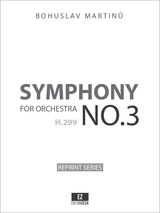
REPRINT SERIES
I. Toccata: Allegro moderato
II. Canzone No.1: Andante moderato
III. Canzone No.2: Allegro (poco); Adagio
Bohuslav Martinů was an early 20th-century composer known for his prolificness and
versatility across a daunting abundance of genres. But of all the forms he experimented and, indeed, excelled at writing, his favorite was the concerto grosso.
This affinity shows itself strongly with this underperformed gem, composed in 1946 during his stint living in the United States, just after he had finished his Fifth Symphony. Martinů wrote that while the symphonic genre offered the broadest scope and "boundless dimensions," the formal, dynamic, and emotional limits of the concerto grosso were of a restrainedness which he enjoyed and blossomed under. He originally conceived of the piece as a return to "less obvious emotion, less noise, and much more music in a condensed form." However, after writing the fairly heavy toccata, his original intention for the canzoni to be light and simple underwent a metamorphosis, and they became much more dramatic and lyrical.
The Toccata, marked Allegro moderato, is a brilliant and compelling perpetuum mobile, featuring murmuring interwoven divisi strings which meld with a restless grumbling piano line. However, despite its incessant persistence in rhythm and in texture, there is an overarching lyricism which makes itself felt in the rhythmic figures as well as the brief but soaring fragments which overlay it. Throughout the movement the piano plays a pivotal role, a conduit between the wind and string sections' continual sixteenth notes.
The two canzones take complimentary moods, one dignified and the other fierce, but both possessing the same rhythmic consistency and integrity as the toccata. Canzone No. 1 is solemn and stately, beginning with dark octaves and a highly chromatic melody in the solo piano. This line is fragmented and augmented by the rest of the orchestra, before the music coalesces into a luminous middle section featuring solo strings and glowing chords from the rest of the orchestra. The climax is an anguished series of falling triplets and chromatic lines; the movement closes as it began.
The second canzone alternates almost startlingly between the aggressive 6/8 which opens it and a much more lyrical theme. The orchestra plays alternating rhythms that seem to vie with each other for dominance over the meter before slowing to a 3/4 middle section which hovers in melancholy and gorgeously expressive unison lines in the violins. But the Allegro of the opening then returns with a vengeance, extended into a furious climax. The closing section, marked Adagio, is a recall of many of the textures and motifs which have dominated this rigorously rhythmic piece. The piece ends in a glorious, incandescent D Major.
- Difficulty:
- Intermediate
- Instrumentation:
- Picc, 2Ob, Cl, Bsn, Tpt, Perc(1), Pno, Strings
- Duration:
- 25 minutes
- Set of Parts:
- Includes Strings count 4.4.3.3.2
- Product Type:
- REPRINT SERIES






